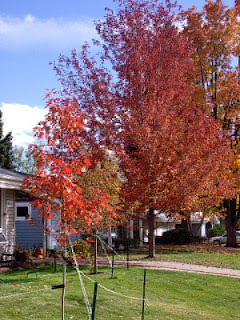
Brian's Park Ice Skating RinkLocated downhill from the downtown of Victor, Colorado they have curtains that shield the winter ice from the sun. The rink is about a half block from my friend's house. To go to
Bison Reservoir you have to be a resident of Victor or be taken as a guest. Bison Reservoir is part of the town water supply system and is located on the backside or west side of
Pike's Peak.

Driving in the mountains of Colorado usually the third week of September will provide you with numerous views of the changing Aspen leaves. This year the leaves are about a week to two weeks late. The amount of pictures one could take and feel justified is amazing. It's just amazing to drive around and look at the beauty. This hillside is right at the turn off to Bison Reservoir.

Looking west from the same spot.

Notice the dirt road heading up the valley towards the lake. That's where we were heading.

It's like this almost everywhere as we approach the promised land.

There's a little stream that runs down past the Douglas Fir trees that is loaded with little Brookies.

Getting closer.

The fishing club stocks the lake and charges members and their guests. That's Dave in the Jamaica hat, our member friend and sponsor. Jimi my fishing buddy and the guy with the cash is also Jim, the caretaker and money collector. Jim has a great job, yeah he gets paid, keeping everyone in line and making sure it is a wonderful place for family and friends. He'll also guide you for big game hunting in the surrounding mountains. The local forest rangers use him when they want to make population counts, he knows where all the game animals hang out.

There are rules and one of them is no swimming, as the sign says but you can't see. Also no boats so only fishing from shore or with waders.

All the silver and gold is concentrated in the caldera of the mountain back where Victor is located. On this mountain it appears to have a vent from the volcanic activity in years, many years, past. One might think this is a connected vent to the main volcano caldera and would also have mineral deposits of value.

Every lake has an inlet and Bison is fed by a small stream that runs between those trees.

If you click on this picture you should be able to see the road up
Pike's Peak on the mountain on the far left. The summit is not visible but is to the right.

Two fly fishermen can be seen in front of the three gigantic rock ridges that provide a dramatic back drop to the lake's east side. These rock ridges continue through and under the lake and provide cover and excellent fishing on the west side of the lake.

Lakes also have outlets and this lake's outlet is at the right edge of the picture.

These
little fluffy clouds become gigantic thunder heads by the time they reach the Kansas border. Be sure to follow the link to the Orb's Little Fluffy Clouds.

The dam neck from the vantage point of the afore mentioned rock ridges. Also note the trailer that is Jim the caretakers headquarters and shelter. He has exposed nails on the bottom step to prevent the bears from standing on the step to get inside his door.

The north shore of the lake. Jim's trailer is visible near the left edge of the picture.

A road passes along the north shore to a couple of cabins that are open for overnight stays. The meadow at the cabins is a grazing area for mountain sheep. They are there almost every morning. We didn't stay there this year as the flues need cleaning and it hasn't been done.

Same road, it's nice and long.

A few shore side leaves.

Aspen leaves decorate a pine tree and it becomes a Christmas tree.

Jimi likes his place on the dam neck for fishing. Not only does he catch lots of fish there the dam works provide protection from the usual winds out of the west.

The weather didn't allow the lake to be very still but I was able to catch some reflection in the calm before the storm.

A usual occurrence in the mountains in the afternoon is the build up of storm clouds and a resultant shower or more.

The storm clouds run up against Pike's Peak and push south and sort of swirl around the lake once or twice before gaining strength and pushing over to the plains.

Pike's Peak socked in and Jimi has locked the gate. The end of a wonderful fishing trip.


























































